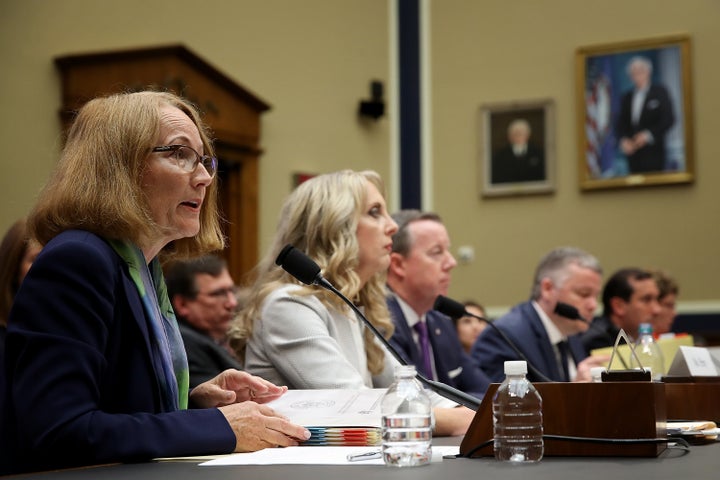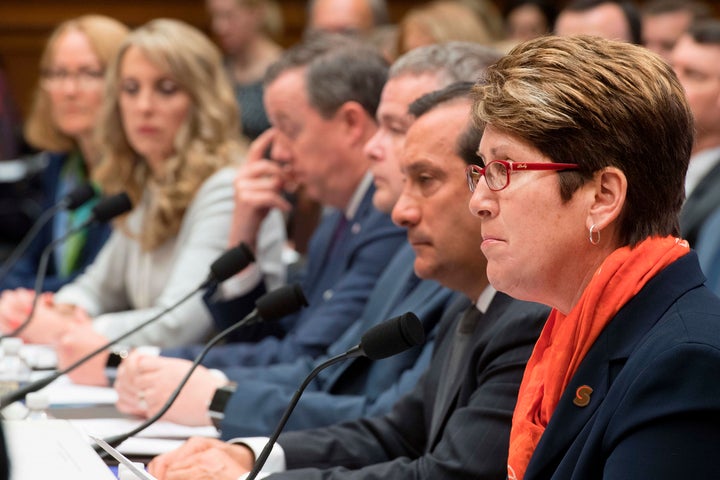
Olympic and Paralympic aspirations are a powerful force, not just for the few who are truly elite, but for all of the 8 million child athletes involved in Olympic sports. The same aspirations that inspire an athlete to willingly train dozens of hours a week, limit social engagements, strictly regulate their food intake, and endure excruciating injuries also make children vulnerable to sexual abuse.
With thousands of tragic stories to put an exclamation point on that well-known research, now is the time for sweeping changes to the Olympic movement.
The issue recently rose to the attention of Congress because of the sex abuse scandal surrounding former USA Gymnastics team doctor Larry Nassar, but sexual abuse is something that has affected multiple national sports organizations under the Olympic umbrella.
On May 23, a panel in the U.S. House grilled the leaders of the Olympic movement on their efforts to protect athletes from sexual abuse. In the U.S., the Olympic movement encompasses the corporate entity known as the U.S. Olympic Committee (USOC), the national governing bodies (NGBs) of 47 sports, as well as clubs, athletes, coaches, administrators and other members. At the hearing, lawmakers kept asking whether the Olympic movement had the necessary congressional authority to protect athletes from sexual abuse, or whether the corporation needed additional statutory power.
This question kept coming up because the USOC had repeatedly defended its actions by asserting that it could not intervene in governance of the individual sports, that these sports were separate businesses. But for the first time, the committee sheepishly acknowledged that Congress had already given it sufficient power to respond to Nassar-like situations. With the number of NGBs embroiled in sex abuse scandals growing to include organizations like USA Swimming and USA Taekwondo, this was a public admission: The problem was not that the USOC and national bodies were unable to protect athletes; it was that they were unwilling to.
Until the USOC commits to broad cultural changes and moves toward a nonprofit model centered on athletes, those athletes will still be at risk.
“Athletes are often defenseless even when trying to assert rights Congress guaranteed to them.”
First, the Olympic movement must look inward and hold its own accountable for ignoring sexual abuse. So far it has resisted efforts to do that. Too many top officials were allowed to resign with grace, like USOC chief executive Scott Blackmun and USA Swimming leaders Pat Hogan and Susan Woessner. Too many current employees knew about the sexual abuse and stayed silent; they enabled the abuse and have suffered no consequences. Victims cannot trust any new system or embrace a sense of justice when the same people continue in the same positions of power over athletes.
Next, lists of banned and suspended individuals must be publicly available for all sports. Just 12 sports publish lists of banned and suspended coaches. The Olympic Committee has the power to require all sports to publish their lists of banned coaches, yet most of the NGBs leave their members and the public in the dark.
The secrecy may protect the “brand” of the five rings and assuage the fear of lawsuits from banned coaches, but the practice endangers athletes. Congress should require the USOC to make sure each sport publishes a list of people who have been suspended or banned and makes it easy to find. The Olympic movement should not be a party to the secrecy that emboldens and enables sexual predators.
The USOC must also enforce its own bans and suspensions. Bans are meaningless if predatory coaches continue to have contact with sports teams and their athletes. When a club nonetheless hires a banned coach or permits access to athletes, what consequences await? Currently, none. There also need to be strong policies to keep banned members away from events sanctioned by the USOC or lower-level bodies. These are private events that banned individuals do not have a right to attend.

Next, the Olympic movement must standardize training on sexual abuse. While the 47 NGBs created their own “SafeSport” programs between 2010 and 2014, it became clear they were inept at rooting out abusers and kept hiring unqualified people to handle the complaints and create educational materials.
After years of foot-dragging, the U.S. Center for SafeSport opened its doors in 2017. Its mission is not just to take complaints, conduct investigations and hold hearings to determine whether a member should receive a sanction ― although those are all crucial SafeSport functions. It’s also meant to lend expertise to NGBs as they develop training materials on sexual abuse. But after almost 15 months on the job, the center doesn’t appear to be doing that.
For example, USA Swimming’s dangerous SafeSport materials encourage athletes to blindly trust their coach, an attitude that is a common precursor to abuse. Even though largest risk of sexual abuse comes from coaches, the materials encourage athletes to confide in their coaches about their personal problems and to trust their coaches to set appropriate conversational boundaries. What they don’t do is give bright-line rules on coaching behavior, and the information that is helpful is drowned out by materials designed to sell the sport to more families.
SafeSport training materials should be well-publicized and contain clear expectations for appropriate relationships and ethical behavior. Athletes of all ages should know that their coach will never text them individually, will not befriend them on social media, will not be alone with them and will not give them gifts. It is not sufficient to prohibit “sexual misconduct” when that phrasing makes it appear that some sexual conduct might be appropriate. Athletes should know that coaches will not pursue a romantic or sexual relationship regardless of age or consent; that these overtures are an abuse of power and are harmful.
Additionally, the Center for SafeSport can only be better than the USOC and NGBs if it has the independence and expertise to match the task at hand. To be independent, the center must hire experts from outside sports, people whose impulse isn’t to protect an institution over athletes.
The center’s chief operating officer, Malia Arrington, exemplifies the center’s problems. Arrington was hired by the USOC in 2010 and moved directly to the center in 2017. She has admitted she was hired without sexual abuse expertise; she worked for a year at the USOC without knowing about the grooming techniques molesters use, essential knowledge for sexual abuse prevention.
Even more alarmingly, she was a key player in the USOC’s quest to deny responsibility for sexual abuse. In a 2016 deposition, Arrington acknowledged that she knew about rapists on certain U.S. national teams, but asserted, “The USOC does not have the authority to do anything.” When Arrington was asked what part of the Sports Act ― the federal law that governs the USOC ― or the corporation’s bylaws supported that assertion, this lawyer, who had been on the job for six years at that point, couldn’t name a single one.
Finally, the USOC needs to redistribute power and resources between the corporation and the athletes fairly. Beyond athlete protection, we need to ask how to give them power. Since 1978, when the Sports Act was passed, Congress has repeatedly tried to give athletes more power over their own destiny, and the USOC has just as often taken that power away, requiring athletes to be submissive, obedient and compliant, or risk not making the Olympic team.
“The Olympic movement must look inward and hold its own accountable for ignoring sexual abuse.”
Athletes are often defenseless even when trying to assert rights Congress guaranteed to them. Take the example of gender equality. In 2016, the athletes of the women’s national hockey team had to strike and hire a lawyer to demand what USA Hockey should have provided: the same support it gave the men’s team. The NGB knew it had been discriminating against the women’s team for decades, but didn’t change its ways until forced. Even now, USA Hockey still spends far more of its resources on male sports development than on the women’s game. The money must be distributed fairly as a matter of leadership; this is America’s team.
To be sure, meaningful change will require fessing up. The Olympic and Paralympic movement has operated as an institutional predator, prioritizing self-promotion through the athletes’ achievements and self-enrichment at the expense of the people it purports to serve, all while feigning trustworthiness.
At last week’s congressional hearing, Rep. Diana DeGette of Colorado said, “I need to be convinced that [the U.S. Center for SafeSport] has a robust system to investigate and stop bad actors.” But among those bad actors is the Olympic movement itself. Without that acknowledgement, and without a willingness to hold those responsible to account and to engage in cultural change that shifts power to athletes, the same patterns are destined to repeat themselves for decades to come. The moment for serious reform is now; for the athletes and for America’s team.
Nancy Hogshead-Makar is an Olympic champion, a civil rights lawyer and CEO of Champion Women, a nonprofit providing legal advocacy for girls and women in sports. Dani Bostick devotes most of her energy to disrupting the culture of shame and silence surrounding sexual abuse and assault.